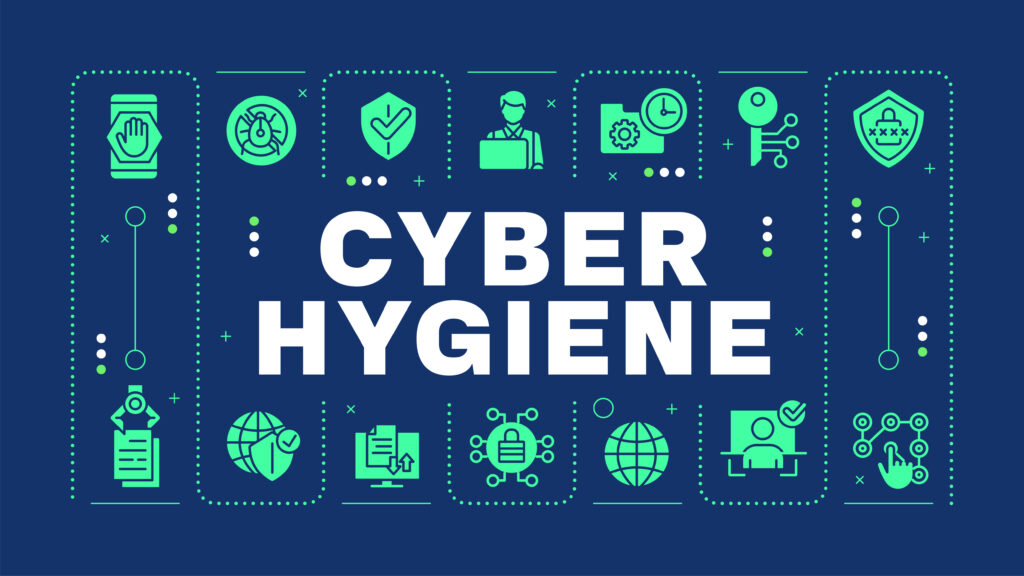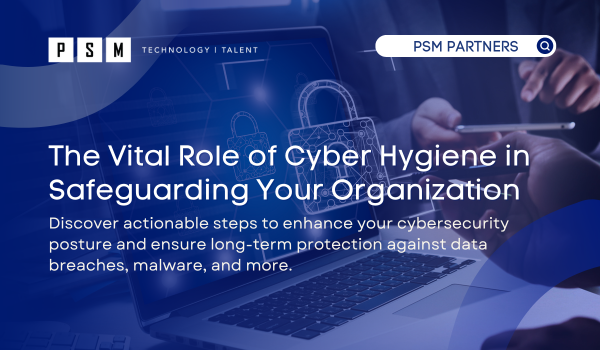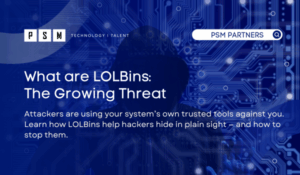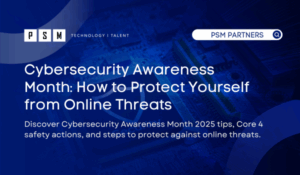Table of Contents
ToggleIn a time when cyber threats are growing more advanced and prevalent, it is crucial for organizations of all sizes to prioritize strong cyber hygiene. Much like personal hygiene, which involves daily routines and habits to ensure well-being, cyber hygiene encompasses the practices and protocols that help safeguard sensitive information and IT systems. A well-implemented cybersecurity program lays the foundation, but without regular maintenance and proactive management, even the best strategies can fall short. Regular cybersecurity hygiene tasks are essential to protect sensitive data, improve recovery capabilities post-attack, and involve all employees in the shared responsibility of maintaining security. By understanding the importance of cyber hygiene, recognizing common problems, and adopting best practices, organizations can significantly enhance their defenses against data breaches, malware attacks, and other cyber threats. This blog will explore the key components of cyber hygiene, its critical role in ensuring security and efficiency, and actionable steps to create a resilient cybersecurity posture.

What is Cyber Hygiene?
Cyber hygiene is much like personal hygiene—it requires consistent, everyday habits to stay effective. Just as individuals engage in personal hygiene practices for well-being, similar practices are essential for safeguarding sensitive data and ensuring the functionality of devices in the digital realm. Once a proper cybersecurity program is in place within an organization, it needs to be maintained through simple daily routines, good behaviors, and occasional check-ups. A strong security posture, often measured by a security rating, reflects how well an organization can prevent cyber threats like data breaches, malware, phishing, ransomware, and personal data exposure. The higher your rating, the better your security practices. Cyber hygiene encompasses everything from hardware and software maintenance to IT infrastructure and cybersecurity awareness training. By following these practices, users can keep systems healthy and improve overall online security.
The Importance of Cyber Hygiene for Security and Efficiency
Creating a cyber hygiene routine is crucial for preventing cybercriminals from causing security breaches, installing malware, and stealing sensitive information from both your organization and your customers. While cybersecurity professionals often manage daily tasks to safeguard this data, it’s essential that every employee understands the basics of cyber hygiene and their role in protecting IT systems and devices. Properly trained employees enable faster incident response and provide immediate defense against cyberattacks.
Beyond security, cyber hygiene helps maintain peak efficiency of your hardware and software. Without routine maintenance, files can become fragmented, and programs can become outdated, increasing vulnerabilities. Regular patching not only enhances security but also introduces improved functionality. Overall, cyber hygiene is beneficial for both maintenance and security, keeping systems efficient while safeguarding against unpredictable cyber threats.
Common Cyber Hygiene Problems
Creating a cyber hygiene routine is crucial for preventing cybercriminals from causing security breaches, installing malware, and stealing sensitive information from both your organization and your customers. While cybersecurity professionals often manage daily tasks to safeguard this data, it’s essential that every employee understands the basics of cyber hygiene and their role in protecting IT systems and devices. Properly trained employees enable faster incident response and provide immediate defense against cyberattacks.
Beyond security, cyber hygiene helps maintain peak efficiency of your hardware and software. Without routine maintenance, files can become fragmented, and programs can become outdated, increasing vulnerabilities. Regular patching not only enhances security but also introduces improved functionality. Overall, cyber hygiene is beneficial for both maintenance and security, keeping systems efficient while safeguarding against unpredictable cyber threats.
Common Cyber Hygiene Problems
Maintaining proper cyber hygiene involves regularly updating and managing a variety of hardware and software, including computers, mobile devices, connected devices, hard drives, cloud storage, and SaaS applications. However, several common problems can arise when this maintenance is neglected:
- Loss of Data: If hard drives, cloud storage, or SaaS applications aren’t regularly backed up or maintained, they become vulnerable to hacking, data leaks, corruption, and breaches.
- Misplaced Data: Without robust data classification, it’s easy to lose track of data due to the numerous places where it can be stored.
- Security Breaches: These are increasingly common and costly. Poor network security, lack of configuration management, and targeted attacks like spear phishing and whaling can expose trade secrets, leading to customer identity theft, industrial espionage, and loss of market position.
- Outdated Software: Without regular security patches, software applications can develop vulnerabilities that hackers exploit.
- Old Security Software: Antivirus software needs to be updated frequently to keep pace with the evolving threat landscape. Continuous security monitoring is a wise investment to prevent gaps.
- Lack of Vendor Risk Management: Many third-party vendors have access to your network or sensitive data, making it critical to manage vendor risks properly.
Addressing these common issues ensures a more secure and efficient IT environment. Ignoring or delaying routine cyber hygiene tasks can lead to significant vulnerabilities, putting both your organization and customer data at risk. Proactively managing your hardware, software, and vendor relationships helps reduce the chances of data loss, breaches, and performance issues. By staying vigilant and implementing regular maintenance practices, organizations can maintain stronger defenses against evolving cyber threats and ensure long-term operational success.
Cyber Hygiene Practices and Best Practices
Maintaining strong cyber hygiene starts with documenting all current equipment and programs. This includes hardware like computers and devices, software programs used on the network, and applications such as web apps or any program not directly installed on devices. Once documented, analyzing the list for vulnerabilities is essential. Unused equipment should be wiped clean, and all software should be kept up to date. Programs that aren’t used regularly should also be removed to reduce risk.
A key step is creating a comprehensive cyber hygiene policy that everyone with network access must follow. This policy should include organizations should using passphrases (15+ characters long) that don’t expire, frequent software updates or upgrades, and keeping hardware like computers updated to maintain optimal performance. New software installs should be properly documented to ensure accurate inventory, and admin-level access should be limited to those who truly need it, with other users given restricted access. Additionally, backing up data to secondary hard drives or cloud storage is vital for securing information in the event of a breach or malfunction.
Implementing a cybersecurity framework and establishing a clear schedule for tasks like weekly software checks ensures consistency in maintaining security. By following these cybersecurity best practices, organizations can protect their IT infrastructure, reduce vulnerabilities, and maintain a more secure and efficient environment.
Implementing Cyber Hygiene in Your Organization
Implementing cyber hygiene in your organization is crucial to maintaining the security and integrity of your sensitive data. To start, it’s essential to establish a routine cyber hygiene procedure that includes regular software updates, security patches, and antivirus scans. This will help prevent security incidents and ensure that your systems are protected against malware and other cyber threats.
Educating your employees on good cyber hygiene practices is equally important. Encourage the use of strong passwords, caution when opening emails and attachments, and avoidance of public Wi-Fi networks. By promoting a culture of cyber hygiene within your organization, you can significantly reduce the risk of security breaches and data loss.
Consider implementing a cyber hygiene checklist to ensure that all employees are following best practices. This checklist should include tasks such as:
- Regularly updating operating systems and software
- Installing security patches and antivirus software
- Using strong passwords and multi-factor authentication
- Backing up data to online cloud storage
- Avoiding public Wi-Fi networks and using virtual private networks (VPNs) for remote access
By implementing these measures, you can maintain proper cyber hygiene and protect your organization’s sensitive data.
Measuring and Improving Cyber Hygiene
Measuring and improving cyber hygiene is an ongoing process that requires regular monitoring and assessment. To measure your organization’s cyber hygiene, consider using a security rating system that evaluates your security posture and provides recommendations for improvement.
Conducting regular security audits is another effective way to identify vulnerabilities and weaknesses in your systems. This will help you prioritize areas for improvement and implement measures to strengthen your cyber hygiene.
To improve your cyber hygiene, consider implementing the following measures:
- Regularly review and update your security policies and procedures
- Provide ongoing training and education to employees on cyber hygiene best practices
- Implement an incident response plan to quickly respond to security breaches
- Continuously monitor your systems for signs of malware and other cyber threats
- Use security software and tools to detect and prevent security breaches
By regularly measuring and improving your cyber hygiene, you can maintain a strong security posture and protect your organization’s sensitive data.
Enhance Your Cyber Hygiene: Maintaining Cyber Hygiene with PSM Partners
In a world where cyber threats are increasingly sophisticated, prioritizing cyber hygiene is essential for protecting your organization and maintaining efficient operations. At PSM Partners, we understand the critical need for robust cybersecurity measures tailored to your specific needs. Our comprehensive cybersecurity services help businesses and institutions in the Chicago, IL area safeguard their IT systems. Whether you opt for our managed cybersecurity services, which provide complete management including monitoring, maintenance, and updates, or choose our Security as a Service (SECaaS) for dedicated system security, we are committed to enhancing your cybersecurity posture. Partner with PSM Partners to implement effective cyber hygiene practices that ensure the safety of your sensitive data and the resilience of your IT infrastructure in the face of evolving cyber threats.
Related Insights
What are LOLBins: The Growing Threat
Cybercriminals are becoming increasingly clever at turning everyday tools into...
Read MoreUpcoming Cybersecurity Events in 2026
As technology continues to evolve at a rapid pace, staying...
Read MoreCybersecurity Awareness Month: How to Protect Yourself from Online Threats
Every October, Cybersecurity Awareness Month serves as a reminder of...
Read MoreCybersecurity Trends in Higher Education: What Colleges and Universities Need to Know
Key Takeaways: Your Cybersecurity Questions Answered Higher Education Is Now...
Read MoreAbout the Author

Marisa Maiella
I'm a dynamic Marketing Coordinator with a passion for crafting compelling marketing campaigns and engaging content. Known for my creativity and strategic approach, I am committed to fostering brand growth and enhancing engagement through innovative marketing strategies.





